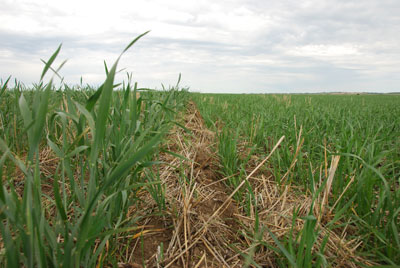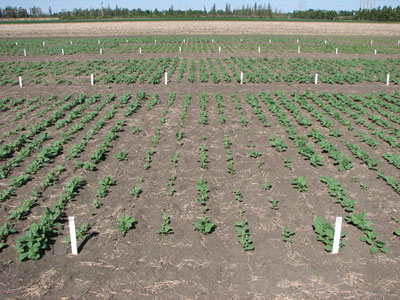
Features
Agronomy
Insect Pests
Seed treatment promotes seedling vigour
Early seeding is a well-established practice for improving crop yields, but it comes with the risk of slow emergence and increased infection from soil and seed-borne diseases.
February 24, 2010 By Top Crop Manager
Early seeding is a well-established practice for improving crop yields, but it comes with the risk of slow emergence and increased infection from soil and seed-borne diseases. However, research shows that when applied as a seed treatment, thiamethoxam, a systemic insecticide, increases plant vigour, results in faster and more uniform emergence, and promotes strong stand establishment and higher yields. Although the vigour effect and pest prevention benefits of thiamethoxam are well known, researchers have discovered the extent to which the vigour effect is linked to growing conditions in the field.

|
| Thiamethoxam (left) vigour effect in wheat 56 days after planting compared to check (right). (Photos courtesy of Syngenta)
|
| Best practices for planting in cold soils
Growers who plant into cold soils should not rely solely on seed treatments to obtain better plant stands and plant growth. To maximize yield, it is recommended that growers implement best practices in all of the following areas:
|
During the past three years, Agriculture and Agri-Food Canada
researcher Dr. Bob Elliott and his team have conducted field
experiments at the Saskatoon Research Centre to assess the vigour
effect of thiamethoxam in canola. In 2007, Dr. Elliott conducted field
trials to investigate thiamethoxam’s effect on seed and seedling vigour
in open-pollinated and hybrid canola. When compared to untreated seed,
Helix XTra improved stand establishment by 20 to 32 per cent, shoot
fresh weight and shoot biomass by 1.4 to 2.9 times and seed yield by up
to 30 percent.
The increased vigour effect in cool soils became the focus of Dr. Elliott’s research in 2008 and 2009. “We wanted to investigate the effect of thiamethoxam seed treatments on establishment, growth and yield of open-pollinated and hybrid Argentine canola planted into summerfallow and tilled wheat stubble at low temperatures,” explains Elliott.
Field trials were planted in early- to mid-May when soil temperatures at planting depth averaged 10 degrees C for seven to 10 days. In both the 2008 and 2009 field trials, growing conditions were very cool and frost occurred soon after the canola emerged. “The findings from our trials suggest that thiamethoxam seed treatments not only improve the vigour of canola seedlings planted into cool soil but also improve their tolerance to frost damage,”
says Elliott.
The vigour effect is not unique to canola and has been witnessed by cereal growers in Western Canada. Warren Kaeding is chief executive officer of Wagon Wheel Seed Corp., a seed and commercial grain business in Churchbridge, Saskatchewan. Kaeding applied Cruiser Maxx Cereals to a small part of a field in 2008 and after experiencing the benefits of the vigour effect, chose to treat all but one of his wheat fields with Cruiser Maxx in 2009.

|
|
| Thiamethoxam + fungicides (front left) versus untreated (front centre) versus thiamethoxam alone (front right). | |
 |
|
| Early seeding brings the risk of seeding into cool soils. Seed treatments help to improve stand establishment. Photo by Bruce Barker. |
“We expected to see yield decreases in 2009 because we planted wheat on
wheat without a crop rotation and the seeds had to survive a very cold
spring,” says Kaeding. “Despite these challenges the crops that were
treated with Cruiser Maxx Cereals emerged one and a half to two days
earlier than expected, developed better tillers and larger root
systems. We are now anticipating yield increases of five percent, which
is unusual given this year’s difficult growing conditions.”
Ted Labun, technical field manager with Syngenta Canada, says the results from these studies indicate that this vigour effect, is greater in cool soils (five to 15 degrees C) than in warmer soils (15 to 20 degrees C). “Growers will see the value of the thiamethoxam vigour effect by treating seeds and planting earlier in the year,” he explains.
Kaeding admits that like most growers he uses seed treatments for peace of mind that his crops are safe from pests like wireworm. The vigour effect is an added bonus. “Our research in 2007 through 2009 shows that thiamethoxam offers effective protection against the crucifer flea beetle in canola,” says Elliott. “Improved stand establishment and higher yields that result from the vigour effect are an added bonus to the insect control offered by thiamethoxam.”